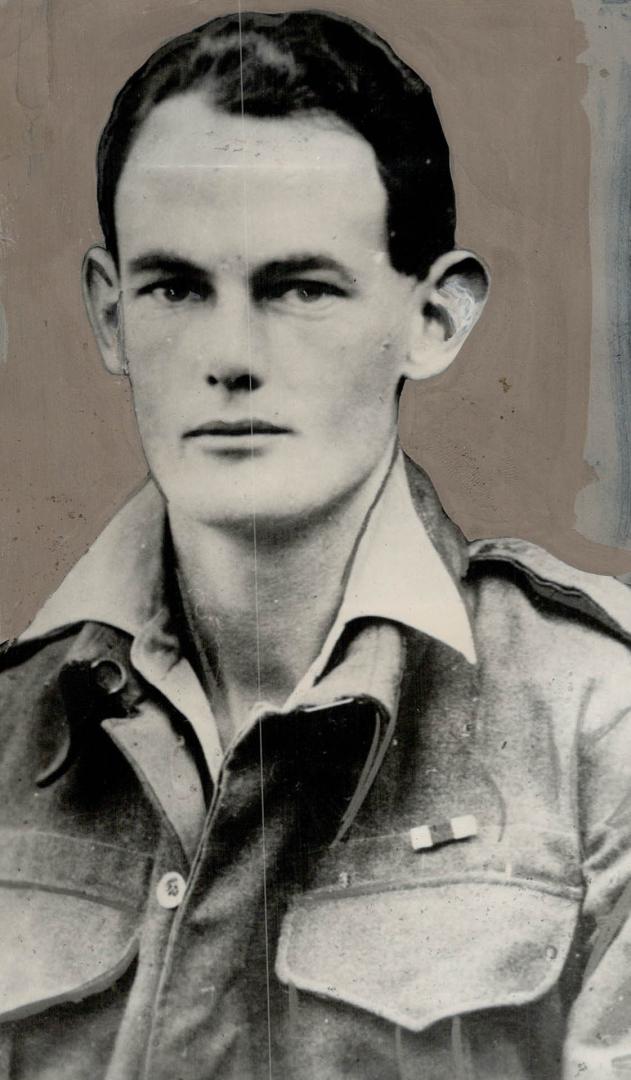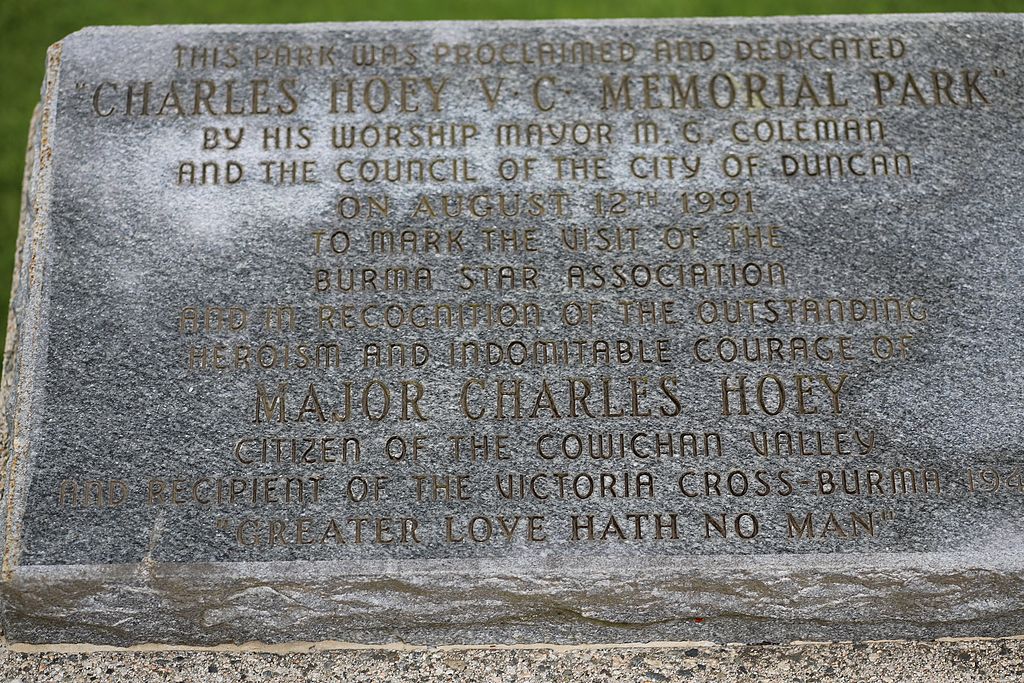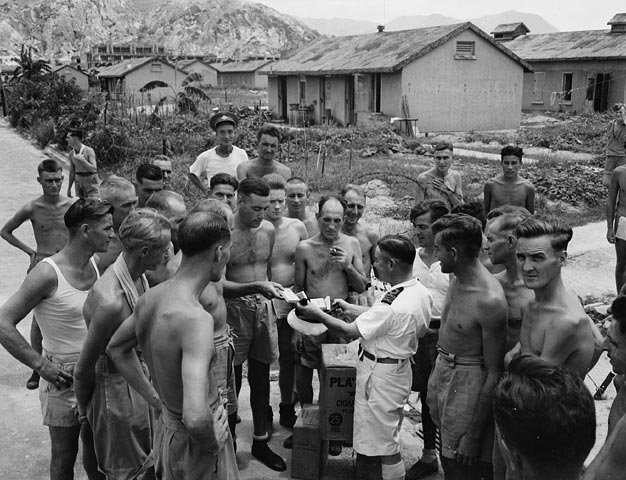Charles Ferguson Hoey, VC, army officer (born 29 March 1914 in Duncan, BC; died 16 February 1944 at the Ngakyedauk Pass, Burma (now Myanmar)). Hoey travelled to Britain, joined the army and rose to major. In February 1944, he led his company in an attack against a Japanese position under heavy machine-gun and rifle fire. Hoey was killed just as the attack succeeded and was awarded a posthumous Victoria Cross for his gallant leadership. (See also Canada and the Asia-Pacific War.)

Early Life and Education
Charles Hoey was the eldest son of Ferguson and Mary Rudyerd Hoey, who had emigrated to Canada in 1911. He was educated at Queen Margaret’s School, Duncan Grammar School and Duncan High School in British Columbia. Hoey’s mother was the daughter of Major-General Charles Rudyerd Simpson, who had been colonel of the Lincolnshire Regiment, which Hoey later joined. Hoey had a brother, Trevor, and a sister, Priscilla.
Hoey was an all-round athlete and accomplished horseman who loved the outdoors. A natural leader, he joined the 1st Qualicum Scout Group and in 1930 enrolled in the militia’s 62nd Field Battery. In April 1933, Hoey sailed to Britain to enlist in the British Army.
British Army
In Britain, Charles Hoey enrolled as a private in the Queen’s Own Royal West Kent Regiment. Two years later, he was awarded a cadetship to the Royal Military College at Sandhurst to undergo officer training. Hoey entered Sandhurst in September 1935 and graduated in December 1936. He was commissioned as a 2nd lieutenant in the 2nd Battalion, Lincolnshire Regiment on 28 January 1937.
After a short time with the 2nd Battalion, Hoey transferred to the regiment’s 1st Battalion, which had been serving in India since 1936. He sailed to the subcontinent in September 1937, where his unit was stationed in Nasirabad (in Pakistan since 1947). The battalion remained there until 11 January 1940, a few months after the Second World War began.
Burma Campaign
In January 1942, Japan invaded the British colony of Burma (now Myanmar) and in March captured the capital at Rangoon (now Yangon). To avoid being surrounded, British and Commonwealth troops withdrew and in May crossed into India, which was also a British colony at the time. The British immediately began planning to recapture Burma.
On 1 March 1942, in reaction to the Japanese advance, the 71st Indian Infantry Brigade was formed, including the 2nd Battalion as one of its units. Charles Hoey moved with the brigade to various locations in India until February 1943, when the brigade was sent to the Maungdaw area in the Arakan region of Burma.
On 5 July 1943, Acting Major Hoey commanded B Company during a raid on a nearby Japanese position. Although his force was delayed by several accidents on the way, it eventually got into Maungdaw and killed at least 22 Japanese and wounded another 30.
As a result of his skilful handling of the force, Hoey’s casualties were only two wounded and one killed. For his outstanding leadership he was awarded a Military Cross and received a Mention-in-Dispatches.
Battle of Ngakyedauk
Between 5 and 23 February 1944, British and Japanese forces fought an intense and costly military engagement. Formally known as the Battle of Ngakyedauk, it is more commonly called the Battle of the Admin Box. The Admin (or Administrative) Box was a 1,100-metre-wide clearing in Arakan province used by the British as a supply depot and staging area.
On 16 February, Temporary Major Charles Hoey’s B Company was part of a small force ordered to capture a key Japanese hilltop position at the Ngakyedauk Pass. The Japanese had surrounded the Admin Box for the last 10 days, and it was hoped the Lincolnshires could ease the pressure on the Box.
A long night march through enemy territory brought Hoey and his men to the foot of the Japanese position at Point 315, which overlooked the eastern half of the Box. The enemy had constructed a heavily defended network of bunkers and trenches there. B Company charged, catching the Japanese by surprise.
The Japanese quickly recovered and responded to the attack with machine-gun and rifle fire from all directions. The British attack slowed. Hoey grabbed a Bren gun from one of his men and, firing from the hip, led his company to the Japanese post. By this point, he had been wounded at least twice in the leg and in the head. Despite his wounds, Hoey’s men had trouble keeping up with him, and he was the first to reach the Japanese strong post.
Hoey killed all the Japanese at the post but was mortally wounded himself. His determination to reach the objective resulted in the capture of the Japanese position, for which he was posthumously awarded the Victoria Cross.
Shortly after Hoey’s courageous action in Burma, his 28-year-old brother, Lieutenant Trevor Hoey, landed in Normandy on 18 July, where he joined the Canadian Scottish Regiment. Two days later at Caen, he suffered multiple severe wounds from the effects of artillery shrapnel and blast. Although he received extensive medical care, Trevor Hoey died the next day, leaving behind his wife and a three-year-old daughter.

Memory
Charles Hoey was originally buried on the hill where he died. His body was later reinterred at the Taukkyan Commonwealth War Graves Commission War Cemetery on the outskirts of Yangon, Myanmar. Due to the intense heat and rain of the region, the grave markers are different from the Portland headstones found in most Commonwealth War Graves Commission cemeteries. Instead, each grave is marked by a bronze plaque set into the ground on a stone pedestal.
On 16 January 1945, the Lieutenant-Governor of British Columbia, William Woodward, presented Hoey’s mother with his Victoria Cross and Military Cross in a ceremony at Government House in Victoria. Today, Hoey’s VC is held by the Museum of Lincolnshire Life, which is housed in a former army barracks and includes the Royal Lincolnshire Regiment Museum.
On 12 August 1991, the Charles Hoey, VC, Memorial Park was dedicated in downtown Duncan, British Columbia. The Charles Hoey Primary School in Duncan, which later became an adult learning centre, closed in 2013.

 Share on Facebook
Share on Facebook Share on X
Share on X Share by Email
Share by Email Share on Google Classroom
Share on Google Classroom






